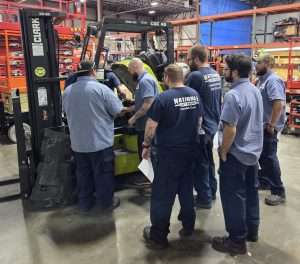
Maximizing Performance and Preventing Costly Damage
At National Lift Truck, we believe that regular training and hands-on expertise are key to keeping our fleet—and yours—operating at peak performance. Last week, one of our seasoned Journeyman mechanics led a comprehensive training session for our newer technicians, focusing on a critical but often overlooked forklift component: the inching pedal.
This combination classroom and hands-on training covered not only the operation of the inching pedal, but also why proper adjustment is essential to forklift maintenance, operator safety, and overall productivity.
What is the Inching Pedal?
The inching pedal is a unique control element found on most forklifts that plays a vital role in maneuverability and precision handling. It allows:
Improved control in tight spaces
Gentle and accurate load handling
Optimized pallet placement
When a forklift operator depresses the inching pedal, it activates a bypass (or “dump”) valve. This valve diverts hydraulic pressure and flow away from the transmission valve body and into the transmission sump. The result? The forklift can hold higher engine RPMs while allowing the operator to inch forward or backward with surgical precision.
Why Adjustment Matters
If the inching pedal is out of adjustment—even slightly—it can cause serious issues. Here’s why:
Short-Term Risks
Increased heat in engine coolant and transmission systems: When the inching pedal fails to fully divert hydraulic flow, the transmission clutch packs remain partially engaged, creating friction and heat.
Overworked cooling systems: Excess heat forces the radiator and cooling system to work harder, leading to overheating fault codes, limp-mode behavior, or even premature cooling system failure.
Long-Term Consequences
Burned clutch discs in the transmission from prolonged partial engagement
Failed torque converters, reducing drive efficiency and requiring costly replacements
Potential head gasket failures, which can cause catastrophic engine damage
These outcomes don’t just result in higher maintenance costs—they also reduce forklift availability, disrupt warehouse operations, and ultimately affect your bottom line.
What Can Be Done?
Regular inspection and precise adjustment of the inching pedal is a simple yet powerful preventive measure. At National Lift Truck, our technicians ensure the pedal travel, dump valve response, and hydraulic diversion are all functioning as designed.
We encourage all forklift owners and operators to include inching pedal checks in their routine PM (preventive maintenance) programs—and to make sure the work is done by certified professionals who understand the hydraulics and mechanics involved.
Investing in Knowledge, Investing in Safety
Training sessions like the one held last week are a reflection of our commitment to continuous improvement. By arming our techs with the latest techniques and in-depth mechanical insights, we not only ensure better service outcomes—we help safeguard the equipment and people our business depends on.
If you’re interested in training opportunities, fleet assessments, or have questions about inching pedal performance on your forklifts, contact us today
